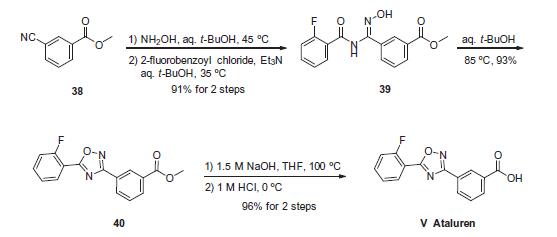|
| | Ataluren (PTC124) Chemical Properties |
| Melting point | 241 - 242°C | | Boiling point | 503.7±60.0 °C(Predicted) | | density | 1.379 | | storage temp. | Refrigerator | | solubility | DMSO (Slightly) | | form | White to off-white solid. | | pka | 3.58±0.10(Predicted) | | color | White to Off-White | | CAS DataBase Reference | 775304-57-9 |
| | Ataluren (PTC124) Usage And Synthesis |
| Description |
Ataluren (PTC124)Cas:775304-57-9 selectively induces ribosomal read-through of premature but not normal termination codons, with EC50 of 0.1 μM in HEK293 cells, may provide treatment for genetic disorders caused by nonsense mutations (e.g. CF caused by CFTR nonsense mutation). Phase 3.
| | Features | Demonstrates oral bioavailability, and an appropriate safety toxicology profile. | | In vitro | Compared with Gentamicin which is only active at much higher concentrations, PTC124 is a more potent nonsense-suppressing agent and exhibits 4-to 15-fold stimulation of read-through relative to controls. PTC124 (0.01-3 μM) promotes dose-dependent read-through of all three nonsense codons in HEK293 cells harboring LUC-190 nonsense alleles with the highest read-through at UGA, followed by UAG and then UAA, but it does not suppress multiple proximal nonsense codons. Like Gentamicin, PTC124 is most active when a pyrimidine (in particular cytosine, C) follows the nonsense codon. Consistent with the stable cell line reporter assay, PTC124 (17 μM) promotes significant production of dystrophin in primary muscle cells from Duchenne muscular dystrophy (DMD) patients or MDXMDX mice expressing dystrophin nonsense alleles. PTC124 selectively promotes ribosomal read-through of premature termination but not normal termination codons, even at concentrations substantially greater than the values achieving maximal activity. | | In vivo | Due to functional recovery of dystrophin production, oral, intraperitoneal or combined dosing of PTC124 for 2-8 weeks partially rescues functional strength deficit in dystrophic muscles of MDX mice, and results in partial protection against contraction-induced injury in the extensor digitorum longus (EDL) muscles, as well as significant reductions in serum creatine kinase values. In Cftr-/-mice expressing a human CFTR-G542X transgene, subcutaneous or oral administration of PTC124 (~60 mg/kg) suppresses the G542X nonsense mutation in a dose-dependent manner, leading to a significant restoration of human (h)CFTR protein expression and function without any effect on nonsense-mediated mRNA decay (NMD) or other aspects of mRNA stability. PTC124 treatment (60 mg/kg) restores 29% of the normal intestinal transepithelial cAMP-stimulated shortcircuit currents observed in Cftr+/+ mice, displaying a significant advantage compared with Gentamicin. | | Description | Ataluren is a drug marketed under the trade name Translarna®
which was developed by PTC Therapeutics and approved by the
European Union in May 2014 for the treatment of Duchenne’s muscular
dystrophy (DMD) and potentially other genetic disorders.
Ataluren renders ribosomes less sensitive to premature stop or
‘read-through’ codons, which are thought to be beneficial in diseases
such as DMD and cystic fibrosis. | | Description | Nonsense mutations create a premature termination of mRNA translation and have been implicated in various genetic disorders, including muscular dystrophy and cystic fibrosis. PTC-124 is a nonaminoglycoside that has been reported to selectively induce ribosomes to read through premature nonsense stop signals on mRNA, thus allowing the production of full length, functional proteins. In a mouse model of cystic fibrosis caused by nonsense mutations, PTC-124 treatment (60 mg/kg s.c. injection or 0.3-0.9 mg/ml orally) has been shown to restore cystic fibrosis transmembrane conductance regulator (CFTR) protein expression and function. The target activity of PTC-124 was initially evaluated by firefly luciferase reporter cell-based nonsense codon assay (IC50 = 7 nM); however, subsequent assessments using a Renilla reniformis luciferase reporter have failed to produce nonsense codon suppression activity. Thus, while PTC-124 is in clinical testing in patients with nonsense mutations within the CFTR or dystrophin genes, controversy surrounds its exact mechanism of action. | | Uses | Nonsense mutations create a premature termination of mRNA translation and have been implicated in various genetic disorders, including muscular dystrophy and cystic fibrosis. PTC-124 is a nonaminoglycoside that has been reported to selectively induce ribosomes to read through premature nonsense stop signals on mRNA, thus allowing the production of full-length, functional proteins. In a mouse model of cystic fibrosis caused by nonsense mutations, PTC-124 treatment (60 mg/kg s.c. injection or 0.3-0.9 mg/ml orally) has been shown to restore cystic fibrosis transmembrane conductance regulator (CFTR) protein expression and function. The target activity of PTC-124 was initially evaluated by firefly luciferase reporter cell-based nonsense codon assay (IC50 = 7 nM); however, subsequent assessments using a Renilla reniformis luciferase reporter have failed to produce nonsense codon suppression activity. Thus, while PTC-124 is in clinical testing in patients with nonsense mutations within the CFTR or dystrophin genes, controversy surrounds its exact mechanism of action.[Cayman Chemical] | | Uses | PTC-124 is a nonaminoglycoside that has been reported to induce ribosomes to read through premature nonsense stop signals on mRNA, allowing the production of full-length functional proteins, | | Definition | ChEBI: 3-[5-(2-fluorophenyl)-1,2,4-oxadiazol-3-yl]benzoic acid is a ring assembly and an oxadiazole. | | Synthesis | The sequence to construct ataluren, which was described by the
authors at PTC Therapeutics, commenced with commercially available
methyl 3-cyanobenzoate (38). This ester was exposed to
hydroxylamine in aqueous tert-butanol and warmed gently until
the reaction was deemed complete. Then this mixture was treated
with 2-fluorobenzoyl chloride dropwise and subsequently triethylamine
dropwise. To minimize exotherm and undesired side products,
careful control of the addition of reagents was achieved
through slow dropwise addition of these liquid reagents. Upon
complete consumption of starting materials and formation of amidooxime
39, the aqueous reaction mixture was then heated to
85 ?? to facilitate 1,2,4-oxadiazole formation, resulting in the tricyclic
ester 40 in excellent yield across the three steps. Finally,
saponification of ester 40 through the use of sodium hydroxide followed
by acidic quench gave ataluren (V) in 96% over the two-step
sequence. 
| | target | CFTR |
| | Ataluren (PTC124) Preparation Products And Raw materials |
|



